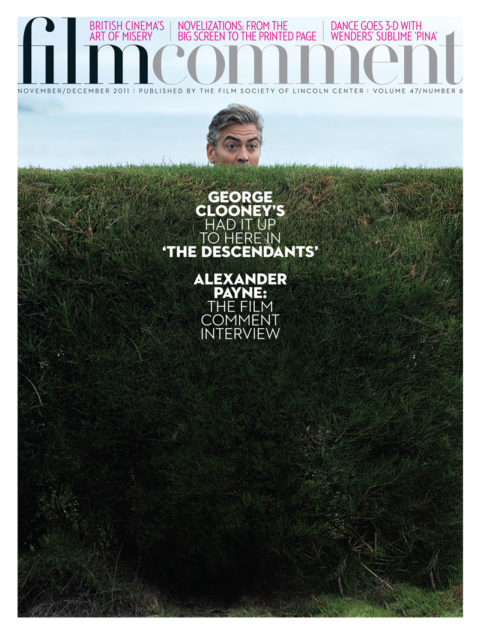
Lusty Man
As American as the apple pie crumbs that occasionally clung to his adorably scraggly moustache while he spoke, George Kuchar—illustrator, painter, writer, actor, “underground” filmmaking titan—was born in Manhattan but raised in the Bronx, a borough that, as his New York Times obituary wryly noted, his speaking voice never left. True enough, everything sounded Bronx-ier, and better—funnier, fruitier, filthier, more flatulent, sometimes filled with flying pie crumbs—when George said it. To hear him speak of Bigfoot, or the cucoloris, or the dirt that collects in The Devil’s Cleavage, or anything associated with the thousand-and-one candy-colored, vomit-encrusted, sin-throttled, and love-smeared “pitch-ahs” he and his twin brother Mike had, together and separately, been making since they were pre-teens in the early Fifties, was to listen to one of the great poetic tongues of the 20th century—the William Carlos Williams of broken wind. When he died on September 6 in his adopted hometown of San Francisco, where he’d lived and taught since the Seventies, Kuchar left behind a world more brazenly befouled and beautiful than he’d found it—a fitting tribute to a filmmaker who described many of his projects as “a kind of trash cinema that used actual trash for sets and strived to elevate the garbage into excrements of excellence. We aimed high and plopped all over the place, but only time will tell if the stench was worth it.”

The Brothers Kuchar began reinventing both Hollywood and “underground” cinema in their own images—ungainly, colloquial, outrageously color-stained, and as lusty as they were forlorn—when their maternal aunt gave the boys, then only 12 years old, some 8mm filmmaking gear in exchange for editing her home movies. Intimate epics soon followed, such as The Naked and the Nude, Pussy on a Hot Tin Roof, and The Wet Destruction of the Atlantic Empire—staged in friends’ apartments, featuring casts of cajoled family members, willing neighbors, and pre-Warhol “superstars.” The Kuchars studied graphic and illustrative “technique” at the School of Industrial Art (now Manhattan’s High School of Art and Design) during the daytime, and filmmaking at double bills of Joan Crawford pictures in the city’s still-glittering movie palaces at night.
By the Sixties, the Kuchars and their “experimental” movies had been adopted by New York’s downtown filmmaking scene, with screenings for the cognoscenti at Ken Jacobs’s loft, and glowing write-ups in The Village Voice. But like the Bronx brothers themselves, always earthy and self-deprecating and in love with pop culture, George and Mike’s movies—funny, gaudy, heartbreaking, fast-moving, and libidinally exuberant—were in many ways the antithesis of those by most of their contemporaries. To compare George’s 1966 masterpiece Hold Me While I’m Naked—as gloriously photographed (in 16mm) and emotionally tormented a portrait of the modern filmmaker’s (oft-ludicrous) burden as Godard’s Contempt or Minnelli’s Two Weeks in Another Town—with the hushed solemnity of Stan Brakhage’s hermetically hypnagogic Dog Star Man, or the pointed patience-testing of Michael Snow’s time-and-space-warping Wavelength, is to experience the greatest disconnect of Sixties avant-garde filmmaking. For the Kuchars, the revolution had already been televised—as a rerun of a Douglas Sirk melodrama on the Million Dollar Movie—and so-called “structural” filmmaking was never even an issue. On Planet Kuchar, Mom’s home cooking, base materialism (usually in the form of a freshly laid turd), and a surfeit of dime-store makeup were all that mattered. A young John Waters was furiously making mental notes.
George and Mike’s filmmaking styles began to diverge and develop increasingly personalized signatures early on, though they would continue acting in and helping to photograph and design each other’s projects for the rest of George’s life. (Mike’s filmography includes one of the key texts of the era, 1965’s Sins of the Fleshapoids, an indelible piece of sci-fi saturnalia starring George in one of his greatest performances.) George’s films, and later videos, never ceased issuing forth at a steady spew. Every year, a couple of new class projects, made with his students at the San Francisco Art Institute, would be joined by a couple of new personal films: portraits of cherished friends and artists, inquiries into UFOs and the alien creatures on the streets of the Mission District where he lived, and “weather diaries” of life on the tornado plains of Oklahoma that he’d edited in-camera with the skill of a brain surgeon and the eye of a meteorologist. The true extent of his filmography remains officially unknown; IMDb’s list of more than 250 films and videos is only partial. (For Kuchar newcomers, Jennifer Kroot’s 2009 doc, It Came from Kuchar, provides an excellent overview.) For those of us who’ve looked at—and in many ways lived by—George Kuchar’s movies for much of our filmgoing lives, the loss of this gentle colossus and garrulous poet of cinema’s soft and sometimes stinky underbelly is incalculable. The world smells so much worse now that he is gone.







